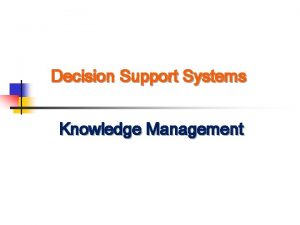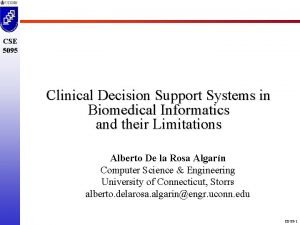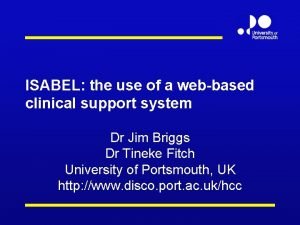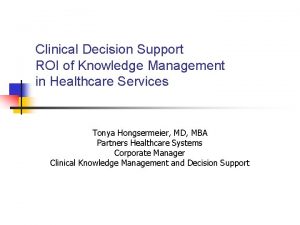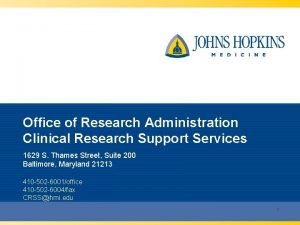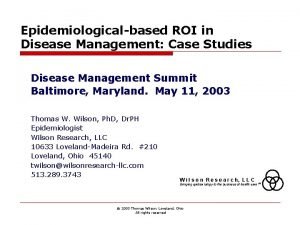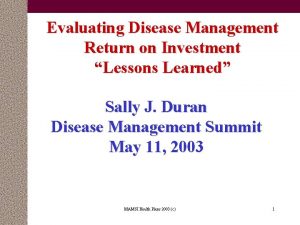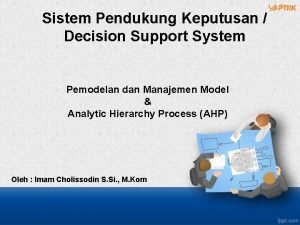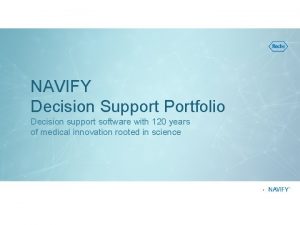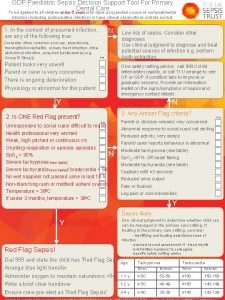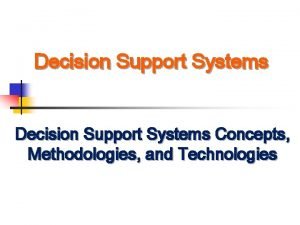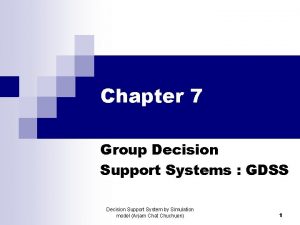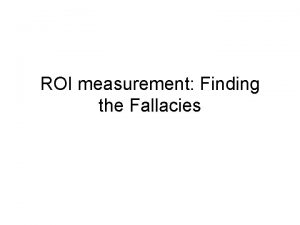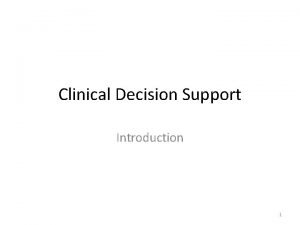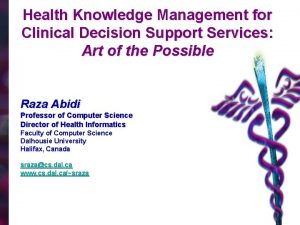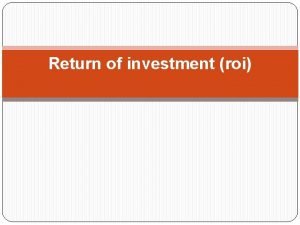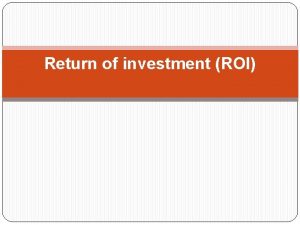Clinical Decision Support ROI of Knowledge Management in



















- Slides: 19

Clinical Decision Support ROI of Knowledge Management in Healthcare Services Tonya Hongsermeier, MD, MBA Partners Healthcare Systems Corporate Manager Clinical Knowledge Management and Decision Support

Stats n n Today, with healthcare expenditures at 14% of GDP, Uncle Sam is paying half of the bill, this will grow with aging population… Medicare, Medicaid and Military beneficiaries Today, there are 4 workers/Medicare beneficiary, by 2079, 2: 1 ratio Numerous efforts to curb inflation: n n Managed Care : reduced resource consumption without patient safeguards DRG-based/case-based reimbursement – Drive-by Bypass surgeries and Deliveries Capitation : Capped suppliers without patient safeguards, Dr’s kept short hours in places without elevator access All Failed

Simplified US Healthcare System CMS/Tri. Care/VA Employers Payors Pharma Hospitals Doctors Consumers Goals: 1) Give consumers greater financial responsibility 2) Reduce Hospitalizations and cost per hospitalization 3) Increase quality performance (NCQA/JCAHO) 4) Reduce drug expenditures 5) Reduce imaging study expenditures 6) Increase wellness/reduced sick days

Employer initiatives now: n Leapfrog : reduce unnecessary adverse events n n n CPOE High Procedure Volume hospitals Intensivists on site HEDIS measures/JCAHO core measures: Value-Based Purchasing Defined Contribution: Consumer determines where to spend first $2000 Consumerism cannot drive down the cost of services unless the value is transparent

Use Case Examples: ROI of CDS in Healthcare n n n Safety and Primary Preventive Care in Inpatient and Outpatient Setting Disease Management and Secondary Prevention – Diabetes, Geriatric Prescribing Roche’s challenge: p 450, a new diagnostic test

In the early 90 s… n n Little tangible business case for quality Increased errors increased resource consumption increased reimbursement for everyone except for DRG case-based reimbursment Selling CDS was impossible Then, the IOM report was published…

Errors Cause Real Harm n n Medical Errors kill between 44, 000 and 98, 000 people each year 7. 3% of hospital admissions incur preventable medication errors n n n 66% of these were not intercepted 25% resulted in patient harm 360 preventable Adverse Drug Events for a hospital with 20, 000 annual admissions, almost 1 ADE per day

Outpatient Adverse Drug Events n Overall n n 25% of outpatients incurred an ADE 39% were preventable Antidepressants and antihypertensives were largest contributors Elderly (over 65) n n n Adverse Events in 5% of population per year 28% preventable New benzodiazepine w/in 30 days doubles risk of hip fracture Cardiovascular agents, diuretics, non-opioid analgesics, hypoglycemics, & anticoagulants were largest contributors Causing falls, strokes, bleeds, renal failure, dementia, etc… Gandhi et al, NEJM 2003; 348(16): 1556 -1564 Gurwitz et al, JAMA 2003; 289: 1107 -16

NEJM: Chances of Receiving Appropriate Preventive Care is about 50% MAKING THE GRADE - Doctors in California were graded using a weighted scorecard on the following: Childhood immunizations - Children who turned 2 years old during the measurement year who received both Chicken Pox and Measles/Mumps/Rubella vaccinations Breast-cancer screening - Women age 50 through 69 who had a mammogram Cervical-cancer screening - Women age 18 through 64 who received one or more Pap tests Asthma - Patients with persistent asthma, in three age groups, who received at least one dispensed prescription for inhalers Coronary-artery disease - Patients age 18 through 75 with major heart conditions who showed evidence of cholesterol screening Diabetes - Patients with childhood and adult-onset diabetes age 18 through 75 who had evidence of blood-sugar screening Note: The above measures account for 50%of the total score. Other measures include patient experience (40%) and investment in technology (10%).

Computer-Based Clinical Decision Support Evidence Shows… n n n 55 -83% decrease in hospital nonintercepted serious ADEs using CPOE 22 -78% increased adherence to preventive health reminders At Partners, Drug-Drug Interaction checking intercepts 5% of physician orders, physicians change their decision about 33% of time Kaushal R, et al. Arch Intern Med. 2003 Bates, JAMA 1998 And Unpublished

Hospital Business Case for Safety and Quality n Preventable Adverse Drug Events add $4685 to an admission n n Sedation exceeding HCFA guidelines occurred in 20% of elderly admissions, adding $5200 or 7. 3 days per case n n n $1. 9 to $3. 8 million annual excess costs in a hospital with 20, 000 annual admissions Nosocomial infections add $100 s to $10, 000 s per case n n n Failure to wean, falls, hip fractures $10. 4 million annual excess costs for a hospital with 10, 000 annual Medicare admissions Pressure Ulcers add $1900 to an admission, sites self-report rates of 510% n n $1. 7 million annual excess costs in a hospital with 20, 000 annual admissions Numerous studies show sub-standard antibiotic prescribing practices in the hospital resulting in excess costs and mortality NEJM study of advanced antibiotic prescribing system showed reduction of $18, 500/case where clinicians accepted advice of system vs cases where advice was ignored Failure to meet JCAHO core-measure goals will result in reduced reimbursement by CMS and Payors in coming years

Most common prescribing error is failure to adjust for renal function… Renal Dosing Calculates Creatinine Clearance First, Then Presents Calculated Default Dose – It’s a 3000 x 4 cell decision table

Geratric Dosing Presents Adjusted Default Dose A 250 -row Decision Table with Multiple Substitution Recommendations

Employer/Payor business case for CDS - Diabetes n n n Estimated avg $21, 000/year per diabetic employee in absenteeism, disability and medical costs (study of 6 employers with 375, 000 employees Glycemic control is associated with $1000 -$2000 medical costs savings/year to payor Currently, we are “reimbursed” to measure Hg. A 1 c annually (captured claim for test ordered) Will soon be reimbursed for maintaining control through test result surveillance, goal is < 7 “Smart Form” = about 300 rules

Composite Decision Support Application: Diabetes Management Guided Data Review Guided Observation Capture Guided Ordering

• Payor contracts withhold money annually to reward good HEDIS performance • This can swing a physician’s compensation by $10 -15 K • We are gathering data (unpublished) that shows that clinicians that use CDS do better than those that don’t • Physicians who are not wired will increasingly find themselves financially penalized

The “Genetic Revolution” Begins Leading the News: Roche Test Promises to Tailor Drugs to Patients --- Precise Genetic Approach Could Mean Major Changes In Development, Treatment June 25, 2003 Roche Holding AG is launching the first gene test able to predict how a person will react to a large range of commonly prescribed medicines, one of the biggest forays yet into tailoring drugs to a patient's genetic makeup. The test is part of an emerging approach to treatment that health experts expect could lead to big changes in the way drugs are developed, marketed and prescribed. For all of the advances in medicine, doctors today determine the best medicine and dose for an ailing patient largely by trial and error. The fast-growing field of "personalized" medicine hopes to remove such risks and alter the pharmaceutical industry's more one-size-fits-all approach in making and selling drugs.

Cytochrome P 450 Test • No data on it’s value • Worse, no knowledge base on how to use the test result • No titration algorithms • No substitution algorithms • Test should be almost as cheap as a creatinine clearance

ROI is always on shifting sand… n n Reimbursement policies always change based on public sentiment, employer/payor maneuvers, and government policies Suppliers are always trying to stay ahead of these policy shifts Aging, Obesity, Diabetes, CAD, Oncology and infectious diseases will continue to drive US inflation Expect new counter-measures if a “magic bullet” is discovered for type 2 DM and it still costs more than a life-time of current standard care….
 Decision support system in knowledge management
Decision support system in knowledge management Tạo hình con rối và sân khấu biểu diễn rối
Tạo hình con rối và sân khấu biểu diễn rối Iliad clinical decision support system
Iliad clinical decision support system Isabel clinical decision support
Isabel clinical decision support Knowledge management roi
Knowledge management roi Objectives of decision making
Objectives of decision making Investment decision financing decision dividend decision
Investment decision financing decision dividend decision Knowledge based decision support system
Knowledge based decision support system Clinical research support services
Clinical research support services Disease management roi
Disease management roi Disease management roi
Disease management roi Decision tree and decision table
Decision tree and decision table Types of tps
Types of tps Components of decision support system
Components of decision support system Contoh decision support system
Contoh decision support system Navify decision support
Navify decision support Decision support systems and intelligent systems
Decision support systems and intelligent systems Gdp sepsis decision support tool
Gdp sepsis decision support tool Components of decision support system
Components of decision support system Gdss
Gdss
